
(c.1930)
Raymond Emmanuel Woog (25 October 1875, Paris - 10 May 1949, Neuilly-sur-Seine) was a French painter, designer and illustrator.

Raymond Emmanuel Woog (25 October 1875, Paris - 10 May 1949, Neuilly-sur-Seine) was a French painter, designer and illustrator.
He was a student of Gustave Moreau at the École des Beaux-Arts. In 1903, he was one of the exhibitors at the first Salon d'Automne, where he received critical praise from Arsène Alexandre. Two years later, he married Violette Julie Picard (1882-1968), whose father was a businessman. They had four daughters. [1]
In 1912, following the death of Jules Comte, founder of the Revue de l'art ancien et moderne , Woog took over as provisional manager of the publication. This was interrupted in 1914, at the beginning of World War I. The following year, he was inducted, and spent six months in Flanders. [2] Upon being promoted to Lieutenant, he was posted as an attaché to the British Army. His sketches of English and French soldiers were published in 1916, as 32 plates in a canvas portfolio. It was a limited edition of 150 copies, with the title "Passed by Censor". [3] He was mustered out early in 1918.
He began his career as an illustrator with a cover for the novel, Les Silences du colonel Bramble , by André Maurois, who also served with British troops during the war. Woog is said to have been the inspiration for the novel's narrator, "Aurelle", a French interpreter.[ citation needed ] This served as his entry into the milieu of the press, where he became a good friend of the journalist, Pierre Mille . He would soon be a recognized illustrator for several publications.
In 1928, he travelled to New York, for an exhibition of his works at the Jacques Seligmann gallery. Curiously, his reputation in the United States appears to have been based on his portraits of children. He did, in fact, perform several such commissions while there, but also painted portraits of notable people, such as Maurice Ravel. [2] From 1933 to 1934, he was a regular collaborator with Les Nouvelles littéraires .
He made many long stays in Seine-et-Marne, where he specialized in painting flowers; a theme he would return to when he retired in 1940 and settled in Crest. [2] He was named a Knight in the Legion of Honor in 1947. [4]
Mario Prassinos was a French modernist painter, printmaker, illustrator, stage designer, and writer of Greek-Italian descent.
Georges Gimel, was a French expressionist painter of portraits, landscapes, mountain landscapes, still lifes and flowers. He was also a wood carver, lithographer, illustrator, set designer, sculptor, and enamel painter.
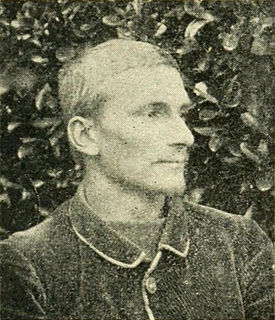
René-Paul Schützenberger was a French Post-Impressionist painter.
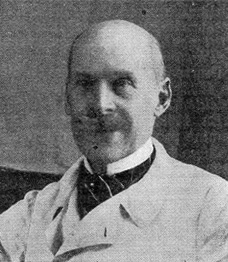
Gaston La Touche, or de La Touche, was a French painter, illustrator, engraver and sculptor.
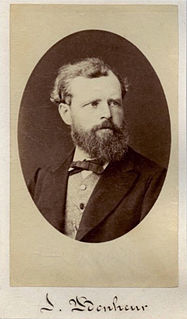
Isidore Jules Bonheur, best known as one of the 19th century's most distinguished French animalier sculptors. Bonheur began his career as an artist working with his elder sister Rosa Bonheur in the studio of their father, drawing instructor Raymond Bonheur. Initially working as a painter, Isidore Jules Bonheur made his Salon debut in 1848.

Robert Antoine Pinchon was a French Post-Impressionist landscape painter of the Rouen School who was born and spent most of his life in France. He was consistent throughout his career in his dedication to painting landscapes en plein air. From the age of nineteen he worked in a Fauve style but never deviated into Cubism, and, unlike others, never found that Post-Impressionism did not fulfill his artistic needs. Claude Monet referred to him as "a surprising touch in the service of a surprising eye".

Jean Messagier was a French painter, sculptor, printmaker and poet. Jean Messagier had his first solo exhibition in Paris at Galerie Arc-en-Ciel in 1947. From 1945 to 1949 the artist worked under the influence of Pablo Picasso, André Masson, Paul Klee and François Desnoyer, his professor at École nationale supérieure des arts décoratifs in Paris. Messagier again was revealed to the public at an exhibition organized by Charles Estienne at the Galerie de Babylone in 1952, entitled "La Nouvelle École de Paris". The following year, Messagier deliberately broke away from his expressionistic form of Post-Cubism; his inspirations now focused on Jean Fautrier and Pierre Tal-Coat to develop a personal vision in which he renders "light...approached abstractly." Jean Messagier is often associated with Lyrical abstraction, Tachisme, Nuagisme, Art informel and paysagisme abstrait, though the artist himself had never accepted any labels, and had always refused the distinction between abstraction and figuration. From 1962 until the year of his death Jean Messagier exhibited in France and abroad, taking part in some major international events as a representative of new trends in French painting.
Lucien Vogt, was an American painter and illustrator.

Jules Marie Auguste Leroux was a French painter and illustrator. His younger brother Georges Paul Leroux was also a brilliant artist who won the Prix de Rome in painting in 1906 and was a member of the Académie des beaux-arts.
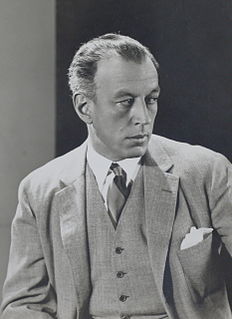
Bernard Boutet de Monvel was a French painter, sculptor, engraver, fashion illustrator and interior decorator. Although first known for his etchings, he earned notability for his paintings, especially his geometric paintings from the 1900s and his Moroccan paintings made during World War I. In both Europe and the United States, where he often traveled, he also became known as a portrait painter for high society clients.

Le Pont aux Anglais, soleil couchant is an oil painting created in 1905 by the French artist Robert Antoine Pinchon (1886–1943). Associated with the new generation of l'École de Rouen Pinchon executed this work in a Post-Impressionist style with a subdued Fauve or Neo-Impressionist palette of golden yellows and incandescent blues. The dynamic image of the train in Pinchon's painting is an homage to the emerging industrialized world.

The Société Normande de Peinture Moderne, also known as Société de Peinture Moderne, or alternatively, Normand Society of Modern Painting, was a collective of eminent painters, sculptors, poets, musicians and critics associated with Post-Impressionism, Fauvism, Cubism and Orphism. The Société Normande de la Peinture Moderne was a diverse collection of avant-garde artists; in part a subgrouping of the Cubist movement, evolving alongside the so-called Salon Cubist group, first independently then in tandem with the core group of Cubists that emerged at the Salon d'Automne and Salon des Indépendants between 1909 and 1911. Historically, the two groups merged in 1912, at the Section d'Or exhibition, but documents from the period prior to 1912 indicate the merging occurred earlier and in a more convoluted manner.

Albert Lebourg, birth name Albert-Marie Lebourg, also called Albert-Charles Lebourg and Charles Albert Lebourg, was a French Impressionist and Post-Impressionist landscape painter of the Rouen School. Member of the Société des Artistes Français, he actively worked in a luminous Impressionist style, creating more than 2,000 landscapes during his lifetime. The artist was represented by Galerie Mancini in Paris in 1896, in 1899 and 1910 by : Galerie Bernheim-Jeune, 1903 and 1906 at the Galerie Paul Rosenberg, and 1918 and 1923 at Galerie Georges Petit.

Paul Biva was a French painter. His paintings, both Realist, Naturalist in effect, principally represented intricate landscape paintings or elaborate flower settings, much as the work of his older brother, the artist Henri Biva (1848–1929). Paul Biva was a distinguished member of National Horticultural Society of France from 1898 until his untimely death two years later.
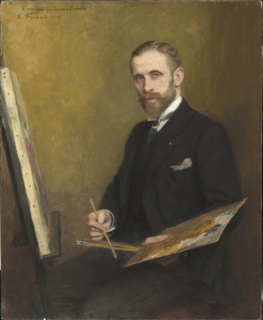
Guillaume Édouard Marie Dubufe was a French painter, decorator and illustrator.
Jean-Pierre Schneider is a French painter and scenographer. A graduate from the École des beaux-arts de Lille, he has been exhibiting since 1969 in Paris, in the province and abroad.

Jacques Hérold was a prominent surrealist painter born in Piatra Neamț, Romania.
Jacques Yankel, born Jakob Kikoïne was a French painter, sculptor, and lithographer.
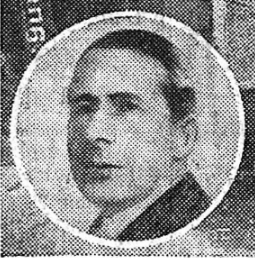
William Albert Ablett was a French painter, designer and engraver of English ancestry. He is best known for his fashionable portraits of women.

Jacques Thévenet was a French painter and illustrator.
| Wikimedia Commons has media related to Raymond Woog . |